I have the following problem. Given are two data sets in 2D space. The two data sets are 2D measurement points from a central point given in the example by (0,0). I need to central project the points of the first data set (x1, y1) on line segments defined by the second data set using linear interpolation between the points.
import numpy as np
import matplotlib.pyplot as plt
x1 = np.arange(-50, 50, 1)
y1 = 50+np.random.rand(100)*5
x2 = np.arange(-20, 30, 50.0/320)
y2 = 30+np.random.rand(320)*0.5
plt.plot(x1, y1, '*',
x2, y2, 'x',
0.0, 0.0, 'o')
plt.show()
I have already implemented the classic line intersection calculation for all lines connecting the set1 with the source point and the line segments of the set2. Unfortunately the nasted for loop is not very efficient.
Is there a way to get this algorithm run faster? Maybe a vectorized implementation?
Any ideas? Thank you in advance.
OK. Let me redefine the problem.
I have the following code:
import numpy as np
import matplotlib.pyplot as plt
import time
set1 = np.zeros((100, 2))
set2 = np.zeros((320, 2))
set3 = np.zeros((100, 2))
# p1
set1[:, 0] = np.arange(-50, 50, 1)
set1[:, 1] = 50+np.random.binomial(5, 0.4, size=100)
# p2 and p3
set2[:, 0] = np.arange(-20, 50, 70.0/320)
set2[:, 1] = 30+np.random.binomial(8, 0.25, size=320)
# p0
sp = np.array([0.0, 0.0])
tstamp = time.time()
# building line direction vectors
s1 = set1 # set 1 is already the direction vector as sp=[0,0]
s2 = set2[1:] - set2[0:-1] # set 2 direction vector (p3-p2)
projected_profile = np.zeros((100, 2))
# project set1 on set2
for i in range(np.size(s1)/2):
intersect_points = np.zeros((100, 2))
ts = np.zeros(100)
ind1 = 0
for j in range(np.size(s2)/2):
# calculate line intersection
div = s1[i, 0] * s2[j, 1] - s2[j, 0] * s1[i, 1]
s = (s1[i, 1] * set2[j, 0] - s1[i, 0] * set2[j, 1]) / div
t = (s2[j, 1] * set2[j, 0] - s2[j, 0] * set2[j, 1]) / div
# check wether we are still on the line segments
if (s>=0 and s<=1 and t>=0 and t <=1):
intersect_points[ind1, :] = t * s1[i]
ts[ind1] = t
ind1 += 1
# take the intersection with maximal distance from source point (sp)
if ts.sum()>0:
projected_profile[i, :] = intersect_points[np.argmax(ts), :]
print time.time()-tstamp
plt.plot(set1[:, 0], set1[:, 1], '*',
set2[:, 0], set2[:, 1], '-',
projected_profile[:, 0], projected_profile[:, 1], 'x',
sp[0], sp[1], 'o')
plt.show()
The code central projects the points in set1 on the curve which is defined by the points in set2 using linear interpolation.

